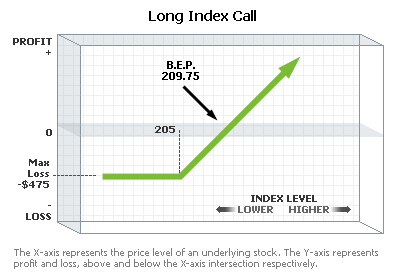Buying Index Calls
Goal: Positioning to profit from an increase in the level of the underlying index.
Description
Market Outlook: Bullish over the short term.
Goal: Positioning to profit from an increase in the level of the underlying index.
- You are anticipating an advance in the broad market or market sector measured by the underlying index in the near future.
- You want to take an aggressive position that can provide a great deal of leverage.
- You make this decision aware of the possibility that you may lose the entire premium you pay for the option.
An index call option gives the purchaser the right to participate in underlying index gains above a predetermined strike price until the option expires. The purchaser of an index call option has unlimited profit potential tied to the strength of advances in the underlying index.
Scenario
Assume that XYZ symbolizes the underlying index that interests you and it is currently at a level of 200. You decide to purchase a 6-month XYZ 205 call for a quoted price of $4.75 per contract. Your net cost for this call is $475 ($4.75 x 100 multiplier). You are risking $475 if the underlying index level is not above the strike price of 205 when the XYZ call expires.
The break-even point (BEP) at expiration is an XYZ index level of 209.75 (strike price 205 + premium paid $4.75) because the call will be worth its intrinsic value of $4.75, which is what you originally paid for it. The higher the XYZ index settlement value is above the break-even point at expiration, the greater your profit.
Possible Outcomes at Expiration
1. XYZ index level above the break-even point (209.75):
If at expiration XYZ index has advanced to 215, the XYZ 205 call will be worth its intrinsic value of $10 (settlement value 215 - strike price 205). Your net profit in this case would be $525 (settlement amount $1000 received from exercise - net cost of call $475).
| Buy XYZ index 205 Call at $4.75 with index at 200 net cost for call = $475 | |||
|---|---|---|---|
| Level of XYZ index at expiration | XYZ index declines to 198 (below strike) | XYZ index advances to 207 (between strike and BEP) | XYZ index advances to 215 (above BEP) |
| Move in level of index | down 2 pts. | up 7 pts. | up 15 pts. |
| Value of call at expiration (per contract) |
0 (out-of-the-money) | $2 | $10 |
| Less premium paid for call | $4.75 | $4.75 | $4.75 |
| Net profit/loss* (per contract x 100) |
–$475 | –$275 | $525 |
*Exclusive of commissions, transaction costs and taxes.
2. XYZ index level between strike price (205) and break-even point (209.75):
If at expiration XYZ index has advanced to 207, the XYZ 205 call will be worth its intrinsic value of $2.00 (settlement value 207 - strike price 205). You could exercise the option and receive the settlement amount of $200 ($2.00 intrinsic value x 100 multiplier). This amount would be less than the net amount paid for the call ($475), but it would offset some of that cost. The net loss in this case would be $275 (net cost of call $475 - settlement amount $200 received from exercise). This loss represents a little more than half of your initial investment.
3. XYZ index level below strike price (205):
If at expiration XYZ index has declined to 198, the call would have no value because it is out-of-the-money. You will have lost all of your initial investment, a net of $475. The net premium paid for an index option represents the maximum loss for an option purchaser.
Note: No matter how far XYZ declines below the strike price, the loss will not exceed $475.


